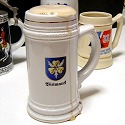
Report of the Commander in Chief, Navy, to the Führer on 4 June 1940 at 1200.
1. The Commander in Chief, Navy, elaborates on the operation of the battleships which began early on 4 June:
a. The situation is favorable on the whole, as so many British ships are undergoing repairs.
b. It is possible to use Trondheim as a base; tankers, minesweepers, motor minesweepers, a repair ship, ammunition reserves, and anti-aircraft batteries are available there.
Sea reconnaissance could be increased.
There is danger from submarines.
c. Situation at Narvik: Large supplies of materiel and foodstuffs are necessary both for us and the Norwegians; consequently considerable convoy traffic is necessary.
An aircraft carrier is at sea about 200 miles from the coast, or off Tromsø.
One to two battleships as well as cruisers and destroyers are off Harstad or in Ofoten Fjord.
d. It will therefore be possible to relieve Narvik as follows:
(2) By attacks to be made on bases by suitable forces if no contacts are made at sea and if air reconnaissance indicates a favorable situation in the fjords.
2. Plans for a landing in Lyngen Fjord have already been discussed with the Luftwaffe.
So far the following has been established: 3,000 men with limited equipment can be transported on the BREMEN.
No heavy cargo can be loaded, however, as the capacity of the cranes is limited to five tons.
An investigation is being made whether a stronger crane can be Installed.
The BREMEN and the EUROPA can be ready in about five days, and will have a speed of 26.5 knots.
It will be necessary to install anti-aircraft guns and to take barges on board to unload materiel.
Necessary preparations: Army and naval officers must carry out air reconnaissance of Lyngen Fjord to investigate landing points, jetties, etc.
Air superiority must be established to cover the time of approach and landing.
A mountain troop is to be held in readiness, and engineers as well as materiel must be taken along.
After the landing, steamers are to proceed to "Basis Nord", as supplies of fuel are limited.
The Navy cannot provide further supplies in the north.
The Führer considers it necessary to take along tanks of approximately 13 tons (Czech) and 8.8 cm. batteries which can if necessary be set up at crossroads.
This however depends on the cranes, on the size of the barges, and on the landing conditions.
As the preparations will probably take some time (the "Feuerstein" group will arrive before these transports), they are to get under way now.
The Commander in Chief, Navy, points out that this transport operation cannot change the difficult situation existing at present; transports by air are necessary.
The Commander in Chief, Navy, suggests that it might be much quicker and easier to land troops by means of freight-carrying gliders instead, for the purpose of seizing the airfield at Bardufoss; further troops could then follow in transport planes.
The Führer states that this will take place simultaneously with the transport operation.
3. The Commander in Chief, Navy, reports that the Navy is detailing four anti-aircraft units to Norway and the west, in the face of considerable difficulties, but that the anti-aircraft defenses of Wilhelmshaven and Kiel or of the Kiel Canal cannot be weakened any further as long as the RAF remains unbeaten.
The Führer is in complete agreement, as Wilhelmshaven and Kiel are the bases for all naval warfare.
4. The Commander in Chief, Navy, draws attention to the fact that the curtailed submarine construction program, which was to be completed 1 January 1942, is being delayed through lack of workmen, iron, and other metals.
Already construction has been held up on submarine pens in Kiel, Wilhelmshaven, and Hamburg, and on submarine harbors and repair workshops.
The Führer explains that he intends to decrease the size of the Army when France has been overthrown and to release all older men and skilled workmen; the Luftwaffe and Kriegsmarine will have top priority.
5. Agreements have been reached with the Italian Navy concerning areas for submarine warfare, etc.
|
 BOOK: The Battleship Bismarck. The Complete History of the Ship.
 Naval & military gifts
|
